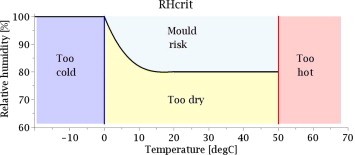Hot Stuff, Big Problems: How Temperature Fuels Mould Growth in Your Home
We all love a cozy home, but crank the thermostat too high, and you might be inviting unwanted guests – mould! While specific temperature preferences differ between species, warm indoor environments generally favour the growth of this fuzzy foe. Let’s explore the science behind temperature and its role in unleashing mould mayhem in your living space.
Mould’s Metabolic Magic Trick: Why Warmth Wins
Mould, like all living organisms, has metabolic processes that fuel its growth. These processes run faster at higher temperatures, allowing mould to reproduce and spread more efficiently. Think of it like a chef – with optimal warmth, the mould’s “culinary skills” are in overdrive, churning out mould spores at an alarming rate.
The Ideal Mouldy Climate
Most mould species thrive in warm environments, with a sweet spot between 60 and 80 degrees Fahrenheit (15.5 to 26.6 degrees Celsius). This temperature range provides the perfect balance for mould to:
- Germinate Spores: Those tiny airborne particles that land on damp surfaces need warmth to come alive and start colonizing.
- Fuel Growth: Once germinated, the mould needs warmth to grow and expand, forming those visible patches we dread.
- Spread Spores: As the mould matures, it produces even more spores, and warm air currents help them disperse throughout your home, potentially reaching new territories to conquer.
Beyond the Thermometer: It’s All About Moisture
It’s important to remember that temperature alone isn’t the sole villain. Mould needs moisture to thrive. Warm temperatures, however, can play a sneaky role in creating a moisture haven:
- Increased Evaporation: Warm air holds more moisture than cool air. So, in a warm environment, surfaces dry out slower, creating a damp breeding ground for mould, even with moderate humidity levels.
- Condensation Chaos: Warm air hitting cool surfaces creates condensation. This is especially common on windows and in poorly ventilated areas. Condensation provides the perfect moisture source for mould to flourish.
Keeping Your Home a Mould-Free Zone
While you can’t control the weather outside, you can certainly influence the climate within your home:
- Maintain a Cool Temperature: Aim for a comfortable indoor temperature between 70-78 degrees Fahrenheit (21.1-25.5 degrees Celsius). This discourages rapid mould growth.
- Dehumidify: Use dehumidifiers to control moisture levels, especially in areas prone to condensation.
- Improve Ventilation: Ensure proper ventilation in your home, particularly in kitchens and bathrooms where moisture is abundant. Open windows and use exhaust fans to remove excess moisture and prevent warm, humid air from becoming a mould magnet.
Remember, a balanced approach is key. By keeping your home cool and dry, you can create an environment less hospitable to mould, preventing its growth and safeguarding your health. Breathe easy, knowing you’ve created a comfortable and healthy indoor environment.


